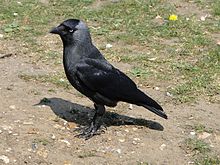Western jackdaw
| Western jackdaw | |
|---|---|
 |
|
|
Corvus monedula spermologus |
|
| Scientific classification | |
| Kingdom: | Animalia |
| Phylum: | Chordata |
| Class: | Aves |
| Order: | Passeriformes |
| Family: | Corvidae |
| Genus: | Corvus |
| Subgenus: | Coloeus |
| Species: | C. monedula |
| Binomial name | |
|
Coloeus monedula (Linnaeus, 1758) |
|
 |
|
|
Jackdaw range
summer-only range
winter visitor only
|
|
| Synonyms | |
Corvus monedula Linnaeus, 1758
The western jackdaw (Corvus monedula), also known as the Eurasian jackdaw, European jackdaw, or simply jackdaw, is a passerine bird in the crow family. Found across Europe, western Asia and North Africa, it is mostly resident, although northern and eastern populations migrate south in winter. Four subspecies are recognised, which mainly differ in the colouration of the plumage on the head and nape. Linnaeus first described it formally, giving it the name Corvus monedula. Later analysis of its DNA suggests that it, along with its closest relative, the Daurian jackdaw, is an early offshoot from the genus Corvus, and possibly distinct enough to warrant reclassification in a separate genus, Coloeus. The common name derives from the word "jack", meaning "small", and "daw", the native English name for the bird.
Measuring 34–39 centimetres (13–15 in) in length, the western jackdaw is a black-plumaged bird with a grey nape and distinctive pale-grey irises. It is gregarious and vocal, living in small groups with a complex social structure in farmland, open woodland, on coastal cliffs, and in urban settings. Like its relatives, Jackdaws are intelligent birds, and have been observed using tools. An omnivorous and opportunistic feeder, it eats a wide variety of plant material and invertebrates, as well as food waste from urban areas. Western jackdaws are monogamous and build simple nests of sticks in cavities in trees, cliffs, or buildings. About five pale blue or blue-green eggs with brown speckles are laid and incubated by the female. The young fledge in four to five weeks.
...
Wikipedia

